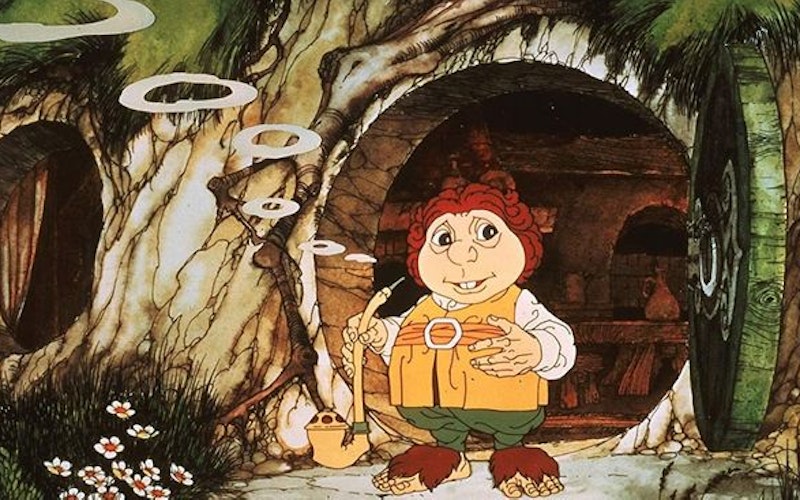
Movies
Spiritual Formation in 1977's The Hobbit
The 1977 Rankin/Bass adaptation of J.R.R. Tolkien’s The Hobbit has never enjoyed a consistent reputation. Today, some elements of the animation hold up wonderfully, such as the genuinely frightening goblins and lamp-eyed Gollum. Other parts—the rudimentary character movement and cheesy original songs—feel more than a little creaky. At roughly 80 minutes, the film also essentially makes a simplified book report out of Tolkien’s original story, something Peter Jackson’s later, live-action trilogy more than compensated for.
The Hobbit’s compression of its source material, however, may actually be a hidden strength. Originally made for television, the Rankin-Bass version sticks to main plot points, while its episodic storytelling contains clear lessons for the character of Bilbo Baggins (voiced by Orson Bean). The end result is a moral arc that highlights the story’s formational aspects. In this incarnation, The Hobbit moves beyond an epic adventure tale to become a parable of discipleship.
The opening of The Hobbit—with Bilbo briefly introduced before the wizard Gandalf (John Huston) shows up to recruit him for a mission, bringing along a posse of dwarves—mirrors Tolkien’s book in its sudden pacing. Gandalf appears out of nowhere, immediately asserting that Bilbo is the right fit to help the displaced dwarves reclaim their kingdom from the dragon Smaug. With his short stature, big eyes, and reluctant voice, Bilbo seems an unlikely candidate. He’s ready to take on the job, however, despite knowing nothing about it. Within moments, he’s hosting Gandalf and the dwarves in his home and then packing up to join them on their quest.
Gandalf’s surprising choice of hero turns out to have incredible consequences—not only for Bilbo, but for Middle-earth itself. Important figures with humble beginnings are also an important part of the biblical tradition. In the Old Testament, God guides Moses, the child of slaves, to lead his people to freedom. He chooses David, a young shepherd, to defeat Goliath and become Israel’s greatest ruler. The tradition continues in the New Testament. Jesus’ disciples don’t come from venerated lines of great priests. They’re mostly fishermen. In fact, Christ’s calling of his closest followers bears striking similarities to the way Gandalf first appears at Bilbo’s home. In Matthew 4, he calls Peter and Andrew while they’re fishing, telling them simply to “Come, follow me . . . and I will send you out to fish for people.” He later calls James and John the same way.
The disciples’ faith is tested when Jesus sends them out in Mark 6 to preach the gospel on their own. Similarly, Bilbo faces his own trials, which increase his confidence and uncover surprising capabilities. After Gandalf’s band of travelers escapes a group of trolls, Bilbo discovers a valuable cache of weapons. Later on, Bilbo uses his wits to outsmart Gollum in a cave, where he obtains the One Ring. With Gandalf’s assistance, he also helps the dwarves escape a goblin horde.
TC Podcast: Tolkien Theology
The real challenge comes when Gandalf eventually leaves the group, with Bilbo unexpectedly in charge. Bilbo protests he’s not up to the job. “I’m no equal to a wizard!” he exclaims. Gandalf sagely replies, “Soon you’ll find out there’s more to you than you guess.” Gandalf, of course, is right. After he departs, Bilbo single-handedly defeats a giant spider that has trapped the party. Shortly after that, the group is taken prisoner by elves. Bilbo, using the One Ring’s cloaking powers, evades capture and figures out a way to smuggle his comrades to safety.
The speed of the storytelling in the Rankin-Bass adaptation, complete with pauses for intended commercial breaks, makes each of these experiences feel serialized, containing individual lessons for Bilbo that build to something greater. In the encounter with the trolls, he realizes he’s resourceful. In meeting Gollum, he discovers his ability to think on his feet. Gandalf’s departure helps Bilbo put what he’s learned into practice.
The film also depicts the physical and emotional enormity of what Bilbo is up against. The monstrous creatures the party encounters are genuinely frightening: the goblins with their imposing size, huge mouths, and lizard-like features; the massive spider with its red eyes and skittering legs. The natural settings aren’t exactly welcoming, either; the party usually walks under stormy skies or through shadowy caves painted in bruise-hued watercolors, which contrast with the lush, sunny green of Bilbo’s home in the Shire. That visual context makes Bilbo’s gameness and heroic transition seem even more impressive.
By the end of the journey, Bilbo is profoundly changed. He’s gained a wider knowledge of the outside world and discovered abilities he didn’t know he possessed. Gandalf, however, has known the whole time what he was capable of. Like Jesus’ selection of his disciples, Bilbo’s potential was why Gandalf chose him to come on the dwarves’ quest in the first place. And, like the disciples’ journey in the gospels, Bilbo’s own experiences remind us that with guidance and a faithful heart, we too, have the potential to do surprising things for the good of others.
Topics: Movies